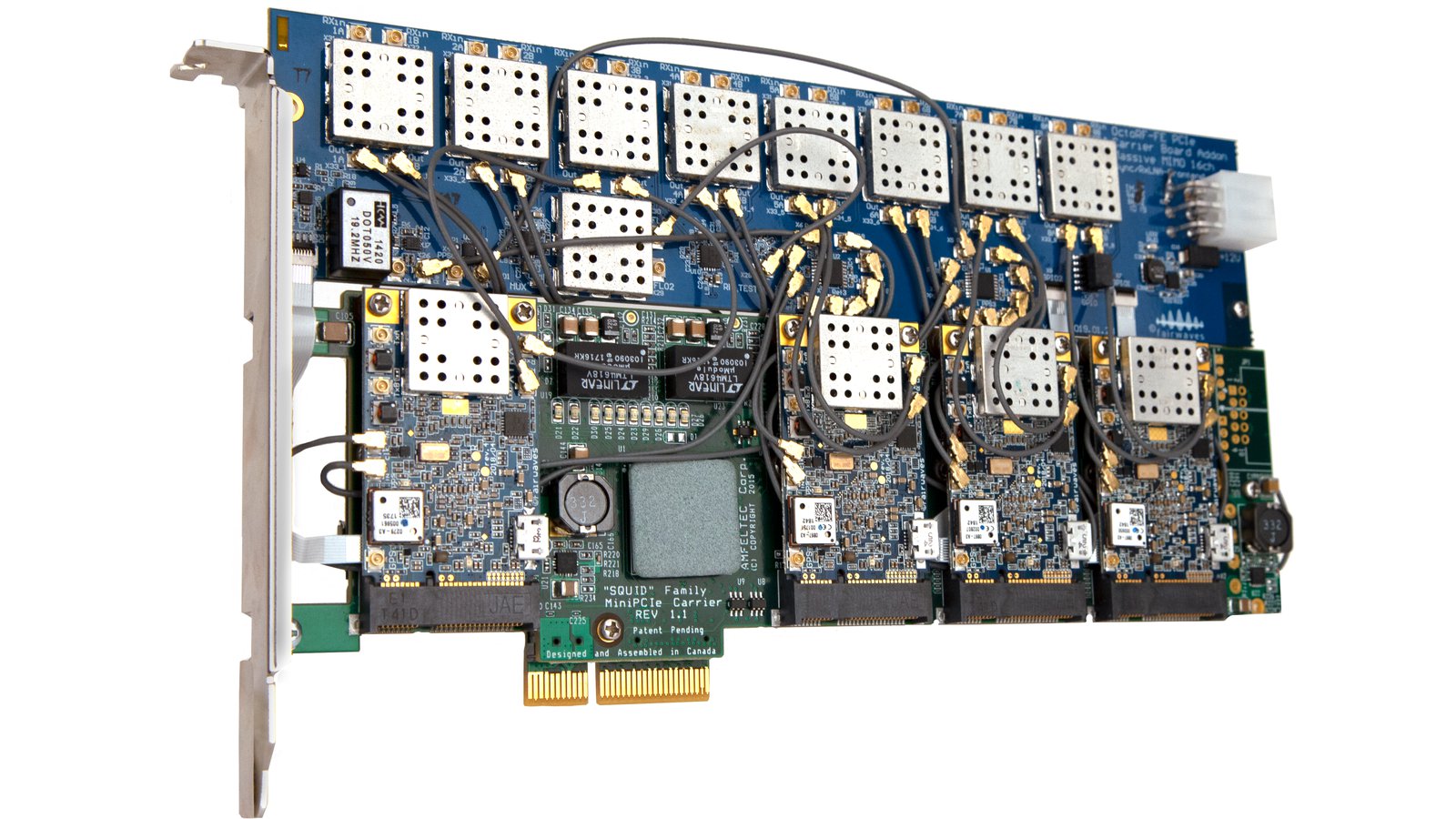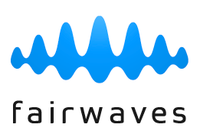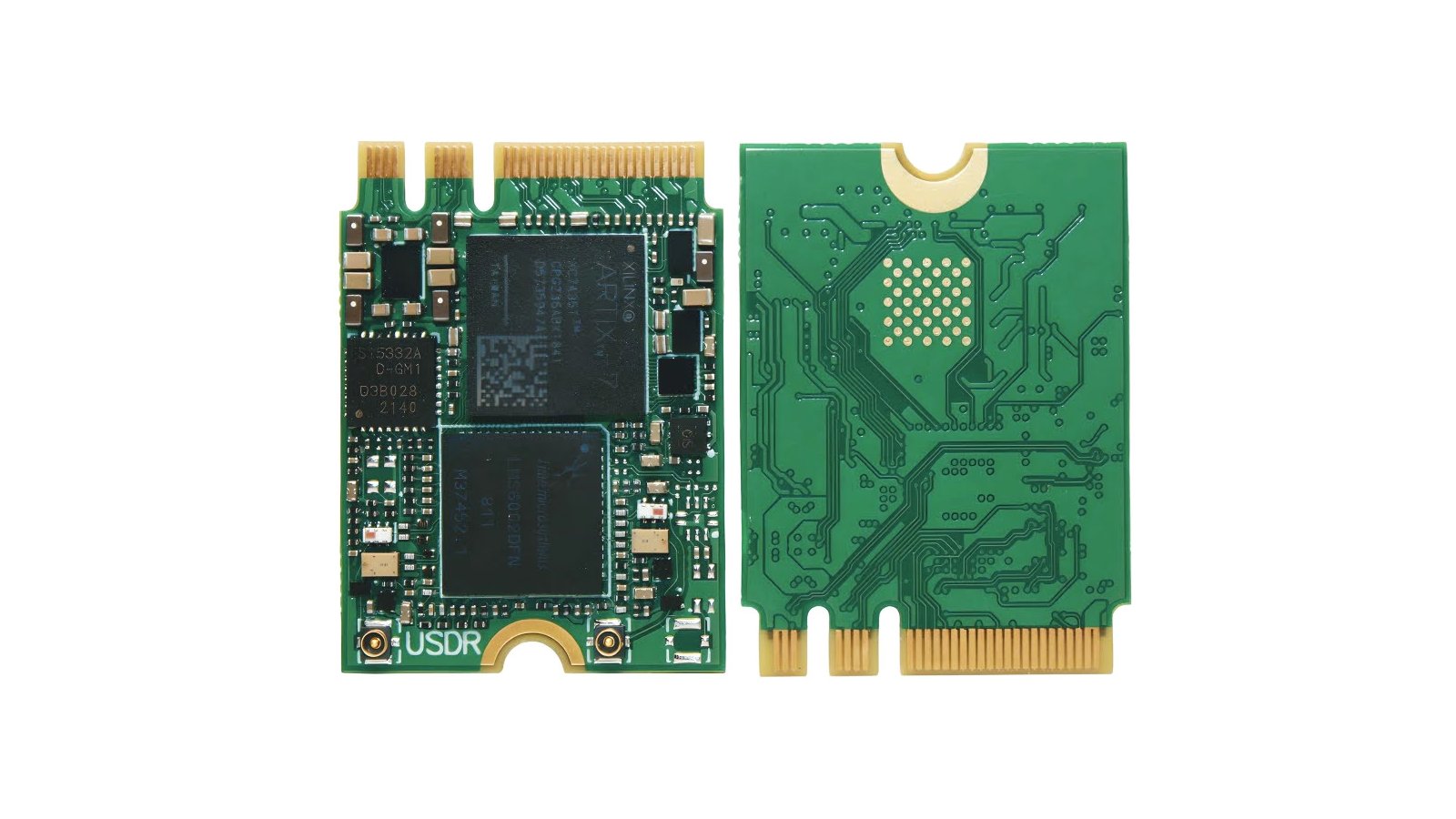Fairwaves
Software Defined Radio
Lime Microsystems
Fairwaves
Software Defined Radio
Lime Microsystems
If you’re working on a massive MIMO system or have a large swath of spectrum you need to monitor, XYNC (pronounced iks-sync) is right for you. XYNC builds on the success of the Octopack SDR we offered during the XTRX campaign and takes into account feedback from the original Octopack users.
You can connect two XYNC boards, either to increase the number of RX/TX channels (e.g., two XYNC Octos give you 32 TX and 32 RX channels) or to increase throughput per channel (e.g., two XYNC Quadros give you twice the throughput of a single XYNC Octo). Connecting more than two XYNC boards is also possible, but requires an external clock and 1 pps signal distribution circuitry, neither of which is provided as part of this campaign.
| XYNC Model | Included XTRXs | Transmit | Receive |
|---|---|---|---|
| XYNC Quadro | 4 | 8 channels (4 independent pairs), 30 MHz - 3.7 GHz | 8 channels (4 independent pairs), 30 MHz - 3.7 GHz |
| XYNC Quadro 6 GHz RX | 4 | 8 channels (4 independent pairs), 30 MHz - 3.7 GHz | 8 channels (4 independent pairs), 1.8 GHz - 6 GHz |
| XYNC Octo | 8 | 16 channels (8 independent pairs), 30 MHz - 3.7 GHz | 16 channels (8 independent pairs), 30 MHz - 3.7 GHz |
| XYNC Quadro Tandem | 8 | 16 high-throughput channels (8 independent pairs), 30 MHz - 3.7 GHz | 16 high-throughput channels (8 independent pairs), 30 MHz - 3.7 GHz |
| XYNC Quadro Tandem 6 GHz RX | 8 | 16 high-throughput channels (8 independent pairs), 30 MHz - 3.7 GHz | 16 high-throughput channels (8 independent pairs), 1.8 GHz - 6 GHz |
| XYNC Octo Tandem | 16 | 32 high-throughput channels (16 independent pairs), 30 MHz - 3.7 GHz | 32 high-throughput channels (16 independent pairs), 30 MHz - 3.7 GHz |
Please contact us directly if you’re interested in custom designs, R&D support packages, or volume pricing.
A single XYNC comes equipped with four or eight removable XTRX boards, metal installation brackets, cables for all of the TX/RX ports and the GPS port, and a special board for synchronizing the XTRX units. Each onboard XTRX provides two transmit channels and two receive channels. Thus, XYNC Quadro (with four XTRX units) has eight transmit and eight receive channels, and XYNC Octo (with eight XTRX units) has 16 transmit and 16 receive channels. Two XYNC Octo can be synchronized and will give you 32 transmit and 32 receive channels.
On the digital side, each XTRX unit is connected to a PCIe switch that multiplexes the XTRX PCIe lanes into a single PCIe 2.0 x4 connector. This makes it very compact and easy to install into a standard PC. Just don’t forget to provide enough air flow for cooling, as setups like this can get quite hot.
XYNC is based on multiple synchronized XTRX SDRs, so the maximum achievable RF bandwidth is a function of the individual XTRX RF bandwidths.
If you want to tune XYNC channels to receive or transmit at different parts of the spectrum, please keep two things in mind:
If you need greater throughput or more channels than a single XYNC can provide, consider a Tandem. As mentioned above, a Tandem is essentially two XYNC boards, connected by a cable and synchronized. Below are the primary reasons to choose an XYNC Tandem:
| 8 TX / 8 RX Channels | 16 TX / 16 RX Channels | 32 TX / 32 RX Channels | |
|---|---|---|---|
| PCIe 2.0 x4 Throughput | XYNC Quadro | XYNC Octo | - |
| 2x PCIe 2.0 x4 Throughput | - | XYNC Quadro Tandem | XYNC Octo Tandem |
| Quadro | Octo | Quadro Tandem | Octo Tandem | |
|---|---|---|---|---|
| No. of XTRXs | 4 | 8 | 8 | 16 |
| Channels | 8 RX / 8 TX | 16 RX / 16 TX | 16 RX / 16 TX | 32 RX / 16 TX |
| Throughput | PCIe 2.0 x4 | PCIe 2.0 x4 | 2x PCIe 2.0 x4 | 2x PCIe 2.0 x4 |
| Price | $4,500 ($5,800 6GHz RX) | $6,500 | $9,000 ($11,600 6GHz RX) | $13,000 |
Again, connecting more than two XYNC boards requires an external clock and 1 pps distribution gear, neither of which is available through this campaign.
XYNC uses a PCIe switch to connect all of its XTRXs to a single PCIe bus. The XTRXs are connected to the PCIe switch with PCIe 2.0 x1 buses, and the switch is connected to the host with a PCIe 2.0 x4 bus, which introduces additional limits to the XYNC sampling rate and throughput compared to a single XTRX.
Expanding on the (theoretical) maximum XTRX throughput limits, we get the following throughput per channel for XYNC Quadro and Octo in various configurations. Green cells indicate combinations of sample rate and PCIe bus configuration where the sampling rate is not limited by the PCIe bus but by the XTRX itself.
| Mode | IQ x Ch x bits | Bits total | PCIe 1.0 x1 (max 1,750 Mbps) | PCIe 2.0 x1 or PCIe 1.0 x2 (max 3,500 Mbps) | PCIe 2.0 x2 (max 7,000 Mbps) | PCIe 2.0 x4 XYNC Total throughput (max 14,000 Mbps) | PCIe 2.0 x4 per XYNC Quadro channel (max 14,000 Mbps) | PCIe 2.0 x4 per XYNC Octo channel (max 14,000 Mbps) |
|---|---|---|---|---|---|---|---|---|
| XTRX | XYNC | |||||||
| 8-bit SISO | 2 x 1 x 8 | 16 bits | 109 Msps | 219 Msps | 438 Msps | 875 Msps | 219 Msps | 109 Msps |
| 12-bit SISO | 2 x 1 x 12 | 24 bits | 73 Msps | 146 Msps | 292 Msps | 583 Msps | 146 Msps | 73 Msps |
| 16-bit SISO | 2 x 1 x 16 | 32 bits | 55 Msps | 109 Msps | 219 Msps | 438 Msps | 109 Msps | 55 Msps |
| 8-bit MIMO | 2 x 2 x 8 | 32 bits | 55 Msps | 109 Msps | 219 Msps | 438 Msps | 109 Msps | 55 Msps |
| 12-bit MIMO | 2 x 2 x 12 | 48 bits | 36 Msps | 73 Msps | 146 Msps | 292 Msps | 73 Msps | 36 Msps |
| 16-bit MIMO | 2 x 2 x 16 | 64 bits | 27 Msps | 55 Msps | 109 Msps | 219 Msps | 55 Msps | 27 Msps |
In the table above, SISO configurations mean that only one receive and one transmit channel is used on each XTRX, i.e. XYNC Quadro would have 4x4 RX/TX channels and XYNC Octo would have 8x8 RX/TX channels. MIMO configurations mean that both receive and both transmit channels are used on each XTRX, i.e. XYNC Quadro would have 8x8 RX/TX channels and XYNC Octo would have 16x16 RX/TX channels. This is why SISO configurations enjoy twice the bandwidth per channel of MIMO configurations – they have half as many channels between which to share that bandwidth.
What exactly does XYNC synchronize? The answer is a bit complex. Below are some important facts you should keep in mind:
Note that the XYNC software package does not currently include the phase calibration algorithm. Please contact us directly if you need support with phase calibration.
XYNC consists of three main units:
The power consumption of the PCIe switch and frontend units is relatively constant at about 10 W for the classical version.
XTRX power consumption varies significantly depending on whether you’re doing RX, TX, or both; on whether you’re doing continuous or burst TX/RX; and on output power, internal gains, bandwidth, digital pre-processing, and a few other parameters. Maximum XTRX power consumption at maximum sample rate and gains is approximately 3 W, which is what we have used for the calculations below:
| Included XTRXs | Maximum Power Consumption | |
|---|---|---|
| XYNC Quadro | 4 | 22 W |
| XYNC Quadro 6 GHz RX | 4 | TBD * |
| XYNC Octo | 8 | 34 W |
| XYNC Quadro Tandem | 8 | 34 W |
| XYNC Quadro Tandem 6 GHz RX | 8 | TBD * |
| XYNC Octo Tandem | 16 | 58 W |
* We have not yet measured the power consumption of the 6 GHz RX frontend. When we do, we will post an update with its power consumption values.
XYNC is powered from two different sources, a PCIe edge connector and a 6-pin 12 V GPU ATX Molex connector:
| PCIe Switch Unit: | PCIe edge connector |
| Synchronization & Frontend Unit: | 6-pin 12 V GPU ATX Molex connector |
| XTRX Units: | PCIe edge connector |
6-pin 12 V GPU ATX Molex connectors, which are typically used to provide power to video cards, look like the following:
In terms of voltages, XYNC uses 3.3 V and 12 V from the PCIe connector and 12 V from the 6-pin ATX connector for the synchronization logic on the synchronization & frontend unit.
With tens of watts of power consumption, cooling is important. Output power and other parameters of the LMS7002M chips we’re using begin to degrade at about 80°C. It’s important to keep the ambient temperature significantly below that to provide enough of a temperature gradient for the chips to cool. If you’re interested in phase stability, it’s also important to keep the temperature as stable as possible – temperature changes can noticeably affect phase stability, causing phase differences between the XYNC channels to drift.
For general applications, we recommend at least providing a stable flow of air through the PCIe compartment. For industrial applications, an external box with a passive heatsink might be a good choice. You can connect such a box to the PCIe bus with a PCIe bus extender.
Fairwaves is happy to work with backers on heat dissipation designs that will keep your XYNC operating safely under its target conditions.
We were quite happy with the quality of the work done by the contract manufacturer (CM) we used to produce XTRX and the original Octopack, so we intend to work with them for XYNC as well. They are located not far from our offices, and we will monitor the manufacturing process closely.
The original XTRX Octopack has already been delivered to backers and customers, and XYNC Quadro and XYNC Octo require only minor improvements to that design. While the 6 GHz RX variants require a new design, we have already built and tested fully functional prototypes.
Our greatest risk is probably our supply chain. As with any project, parts shortages could delay production. That said, we’ve been manufacturing complex hardware since 2013, and we have quite a lot of experience dealing with such challenges. We will post regular updates as manufacturing progresses.
Crowd Supply will be fulfilling orders to our backers and all questions regarding shipments should be directed to them. Take a look at their Frequently Asked Questions (FAQ) page for answers to the most common fulfillment questions.
Produced by Fairwaves in Boston, USA and London, UK.
Sold and shipped by Crowd Supply.

Four XTRXs provide eight TX channels at 30 MHz - 3.7 GHz and eight RX channels at 30 MHz - 3.7 GHz. (Price will increase after the campaign ends.)

Four XTRXs provide eight TX channels at 30 MHz - 3.7 GHz and eight RX channels at 1.8 GHz - 6 GHz. (Price will increase after the campaign ends.)

Eight XTRXs provide 16 TX channels at 30 MHz - 3.7 GHz and 16 RX channels at 30 MHz - 3.7 GHz.

Eight XTRXs provide 16 high-throughput TX channels at 30 MHz - 3.7 GHz and 16 high-throughput RX channels at 30 MHz - 3.7 GHz. (Price will increase after the campaign ends.)

Eight XTRXs provide 16 high-throughput TX channels at 30 MHz - 3.7 GHz and 16 high-throughput RX channels at 1.8 GHz - 6 GHz. (Price will increase after the campaign ends.)

16 XTRXs provide 32 high-throughput TX channels at 30 MHz - 3.7 GHz and 32 high-throughput RX channels at 30 MHz - 3.7 GHz. (Price will increase after the campaign ends.)

We are a vertically integrated vendor of cellular equipment focused on the needs of emerging markets. We are developing, manufacturing, deploying, and operating turn-key cellular network solutions including radio equipment, towers, power and backhaul all the way to a core network and SS7 interconnect. Our team has been building software-defined radios and systems based on them since 2009 and is well known for its ClockTamer, UmTRX, and UmSITE products.

Classic NES games on open source hardware that fits in the palm of your hand

A tiny, single-sided M.2 SDR board that you can operate easily using your web browser

An embeddable, high-performance SDR in a Mini PCIe form factor